The ultimate head-to-head battle between Amazon Music and Tidal to see which streaming service is worth subscribing to.
As two of the most popular music streaming services, Amazon Music and Tidal offer expansive catalogs of music to subscribers. Both services also offer podcasts, music videos, and exclusive performances.
Given the rich content offerings from both platforms, choosing between the two is justifiably tricky. Differences in music discovery features and user interface should be considered since they can make or break your listening experience.
Luckily, finding out which one’s best for you is easy when you analyze what each platform offers and match it to your preference. Read on as we break down Amazon Music and Tidal’s different offerings!
The Overview
Amazon Music
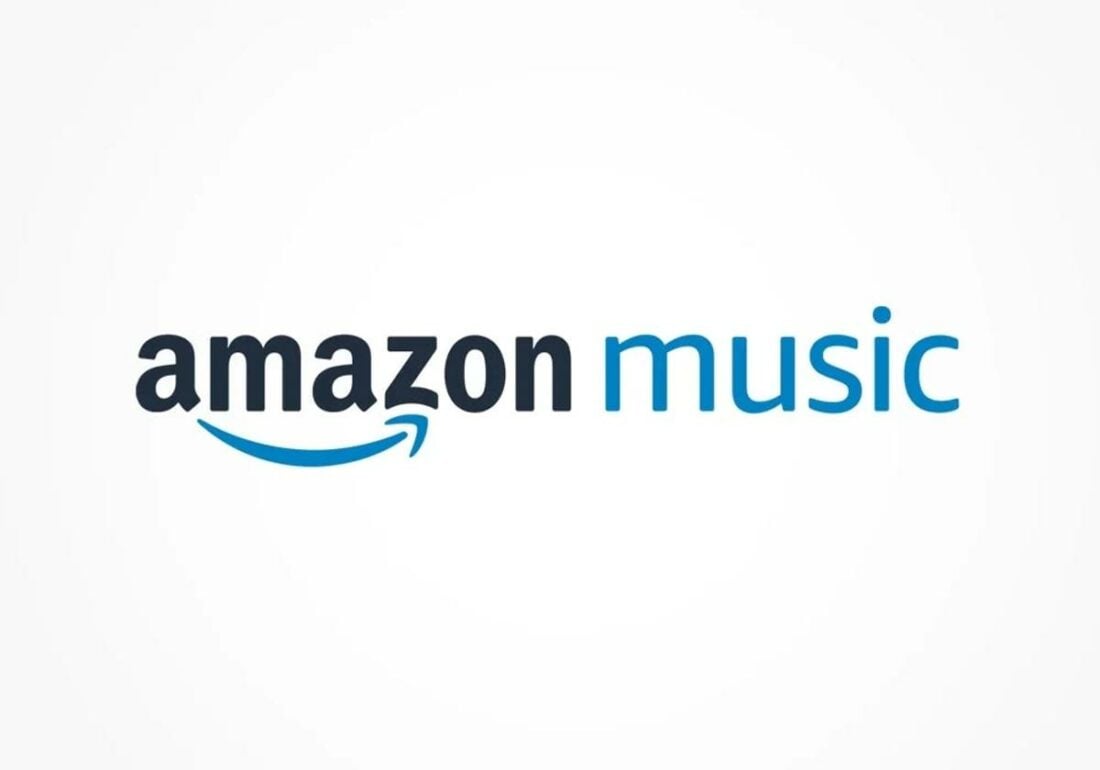
Amazon launched Amazon Music back in 2007 as a digital music store, allowing users to purchase and download music. In 2011, they introduced the Amazon Cloud Player, enabling users to stream their purchased music online.
Over time, the service expanded with the introduction of Amazon Music Unlimited in 2016. Fast forward to 2023, it offers a library of over 100 million songs and a growing selection of podcasts, personalized radio stations, and playlists.
As of May 2023, Amazon Music boasts over 82.2 million subscribers worldwide and is available in 50 countries. Amazon also features integration with Alexa, allowing hands-free playback control.
Tidal
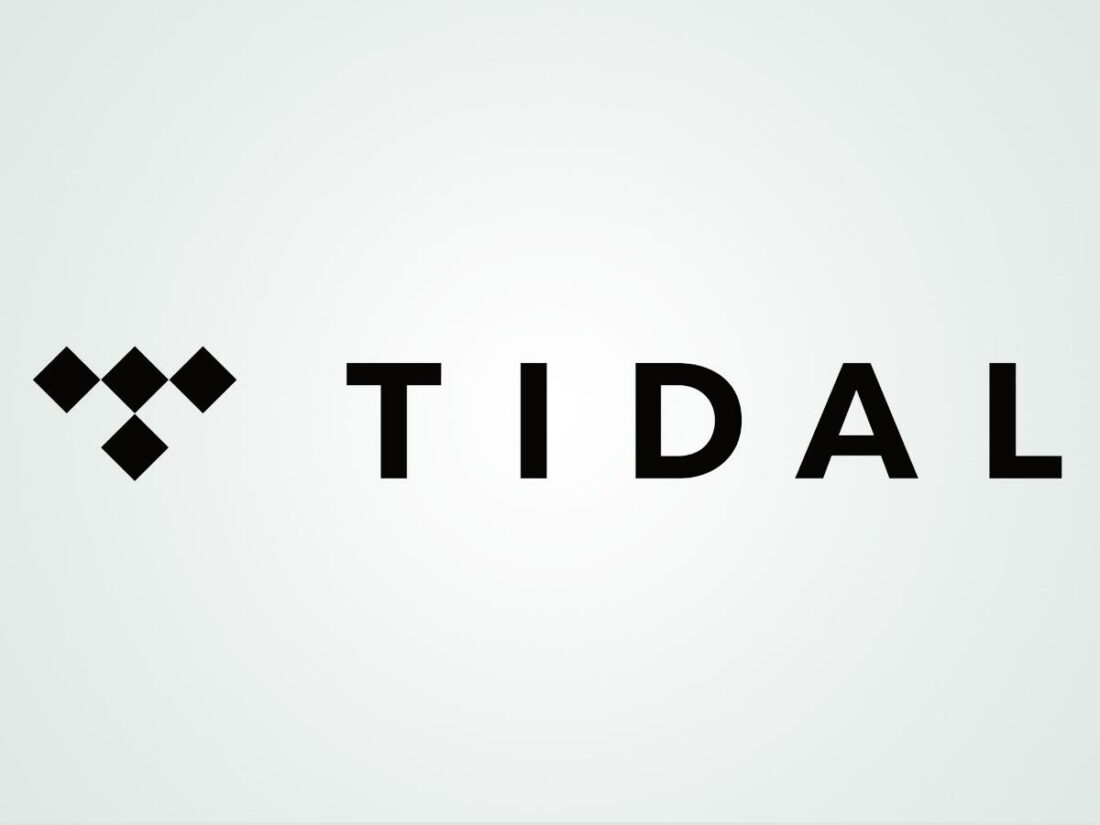
Aspiro, a Norwegian tech company, launched Tidal in 2014 for the US, UK, and Canadian markets. It was then merged with WiMP, another streaming service they owned.
In 2015, Jay-Z acquired Aspiro under Project Panther Bidco Ltd. A lineup of artists, including Chris Martin, Beyonce, Alicia Keys, and Daft Punk, were announced as co-owners.
After running the platform for six years, Jay-Z eventually sold the majority ownership of Tidal to Block, Inc. However, he and other artists remained as stakeholders. Under the new ownership, Tidal looks to enhance the listener experience and discover a better financial system to support artists.
As of 2023, Tidal has roughly 4.2 million subscribers. However, they’ve inflated this number before, so take that with a grain of salt. The service is also available in 61 countries, with over 100 million songs in its library.
Free Plan Comparison
You can use Amazon Music and Tidal for free if you’re not looking to spend money on your music streaming app. Though you can expect some heavy limitations on the features you get.
Let’s break them down:
| Feature | Amazon Music Free | Tidal Free |
|---|---|---|
| Access to entire library | No | No |
| Ad skips | No | No |
| Background play | Yes | Yes |
| Song skips | Yes (6 skips per hour on mobile; unlimited on desktop) | Yes (6 skips per hour on mobile; unlimited on desktop) |
| On-demand playback | No (Shuffle mode only) | No (Shuffle mode only) |
| Offline listening | No | No |
| Best audio quality setting | Standard (128 - 192 kbps*) | High (160 kbps) |
| Audio quality settings | Three settings: Best Available Data Saver Standard | Two settings: Normal High |
Verdict: Which is more worth it?
The free plan on these platforms is pretty much identical from top to bottom.
Both services have background play support on mobile and desktop with shuffle-only playback. You also get six skips per hour on both platforms.
While the limitations are identical, there’s a difference in the type of ads you’ll hear.
The ‘ads’ on Tidal come after three skips, and they only promote Tidal’s different paid plans. However, some users reported an increased interruption frequency.
On the other hand, Amazon Music Free serves you ads from third-party companies willing to pay for the ad spot. The ads pop up after every three skips and after 3-5 songs depending on the duration.
Premium Plans and Pricing
Amazon Music and Tidal have subscription plans covering individuals, students, and families. Here’s a table comparing the subscription plans for each platform:
| Free Plan | Individual | Family | Student | Others | |
|---|---|---|---|---|---|
| Amazon Music | Yes | Unlimited: $10.99/month Prime: $14.99/month | $15.99/month | $5.99/month | Single-Device Plan: $4.99/month |
| Tidal | Yes | HiFi: $9.99/month HiFi Plus: $19.99/month | HiFi: $14.99/month HiFi Plus: $29.99/month | HiFi: $4.99/month HiFi Plus: $9.99/month | Military and First Responder HiFi: $5.99/month Military and First Responder HiFi Plus: $11.99/month |
All of the paid plans on Amazon and Tidal offer similar benefits, including:
- Ad-free and on-demand playback
- Over 100 million songs
- Download to listen offline
- Multi-device support
- Free trials
- Beat-by-beat lyrics
However, these two platforms still have key differences that might alter your decision. Among these differences are:
Sound quality selection
Both Tidal and Amazon Music offer two tiers of lossless audio streaming. Tidal has HiFi and Master quality that you can select individually. This means you can adjust the quality depending on your internet connection stability so you get a smooth listening experience. Tidal also has more sound quality options: Normal, High, HiFi, and Master.
On Amazon Music, the HD and Ultra HD quality options are merged as one. The app will select the best quality available for each track, which may result in stutters – especially if you have a spotty internet connection. It also has fewer sound quality options: Data Saver, Normal, and HD/Ultra HD.
Subscription plan options
Both of these platforms divide their plans into three user categories: Individual, Family, and Student. However, each platform also has special plans targeted at specific users. Aside from the paid plans, free plans are also available on both platforms.
Amazon Music’s offering is slightly complicated. It has a regular paid plan, a free plan, and an additional Unlimited plan. Here’s a breakdown of each:
- Amazon Music Free is an ad-supported tier with unskippable 10 to 30-second ads every 3 to 5 songs.
- Amazon Music Prime is an ad-free plan with a $14.99 Amazon Prime membership.
- Amazon Music Unlimited is the dedicated paid plan that lets you access the entire library and unlocks all the features.
Tidal’s plan selections are slightly more straightforward, with a free plan and two paid plan tiers. Let’s break them down:
- Tidal Free is the US-only free plan. As mentioned before, it comes with interruptions reminding you to upgrade to a paid plan.
- Tidal HiFi is the premium plan that unlocks all the paid features except for Master quality, 360 Reality Audio, and Dolby Atmos.
- Tidal HiFi Plus is the top-tier plan that unlocks Master audio quality and extra features like 360 Reality Audio and Dolby Atmos.
Additionally, Tidal platforms also have other plan options targeted at different groups of audiences.
Tidal offers special discounts in its First Responders and Military Personnel plans in addition to the regular plans. Amazon Music offers a Single-Device Plan that grants you the full perks of Amazon Music on an Echo or Fire TV device.
Free trial duration
Deciding which platform to choose can be difficult – but with free trials, you can make a more informed decision.
Amazon Music offers a long 90-day trial period. Given the long list of features and perks you’ll get for free – the offer is too good to decline. However, this only applies to new Amazon Music users.
On the other hand, Tidal only offers a 30-day trial period for new users, which pales compared to Amazon Music’s offering.
Verdict: Which is more worth it?
Tidal’s plans are each a dollar cheaper than Amazon Music. If you pay for Tidal HiFi instead of Amazon Music Unlimited for a year, you’ll save $12.00 – which is not bad.
Tidal also lets you choose between HiFi and Master quality, which is highly beneficial for those bad-internet days. Conversely, Amazon Music’s merged HD and Ultra HD settings may pose an inconsistent listening experience when you have a lousy internet connection.
While Amazon Music’s 90-day trial is incredibly tempting, you may not need that long to figure out whether or not you like the platform.
Who Has Better Content?
When it comes to music streaming services, the amount and variety of content offered can be a significant factor in deciding which platform to choose. Let’s compare their libraries:
Amount of music content
As of May 2023, Amazon Music boasts over 100 million songs and a growing selection of music videos in its library. With that massive library, I had no difficulty finding artists, tracks, or albums I wanted to listen to. From top hits to the freshest names in the indie music scene, I could find it all.
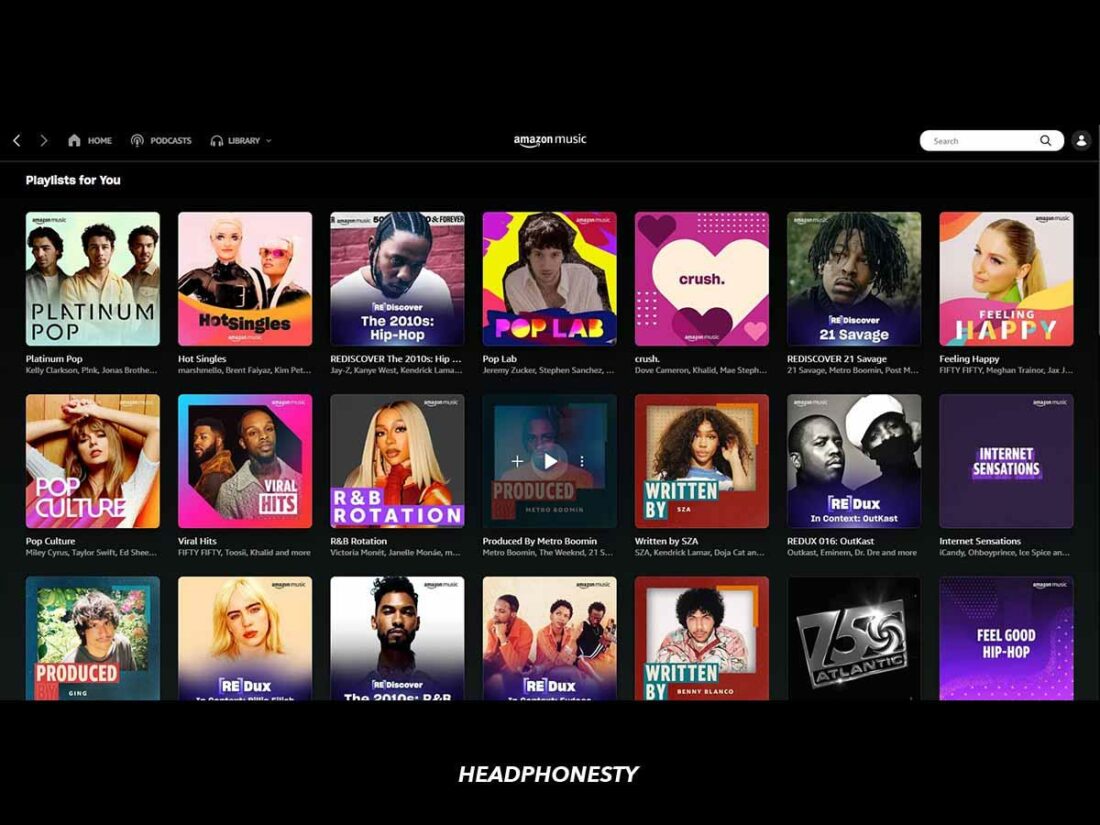
After signing up, Amazon Music greets you with hundreds of curated playlists based on the artists you follow, genres, top albums of the week, and more. Taking a peek into the Search tab, you’ll see a list of 18 genres and 9 moods to browse through.
Clicking on each genre or mood will take you into an expanded library of playlists, new releases, and a sub-category to narrow down your music exploration to a specific era or style.
Similarly, Tidal has over 100 million songs and 650,000 music videos in its arsenal. Being artist-led, Tidal also features plenty of exclusive music and playlists from artists, such as Beyoncé’s Tidal Exclusive and Jay-Z’s 4:44.
Jumping to the Explore tab, you’ll see a list of 25 genres and 29 categories based on moods and activities, making it significantly more expansive than Amazon Music despite having a similar library size.
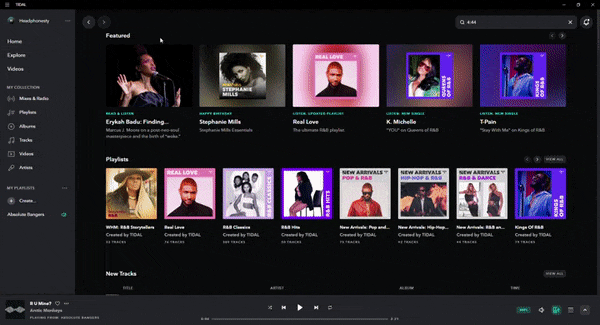
Not only that, but Tidal also offers more depth of content for each genre and category. Clicking on a category takes you to an extensive content page featuring playlists, videos, artists, and tracks.
Content variety
Regarding content variety, both Amazon Music and Tidal have their own collections of non-music content curated for different audiences.
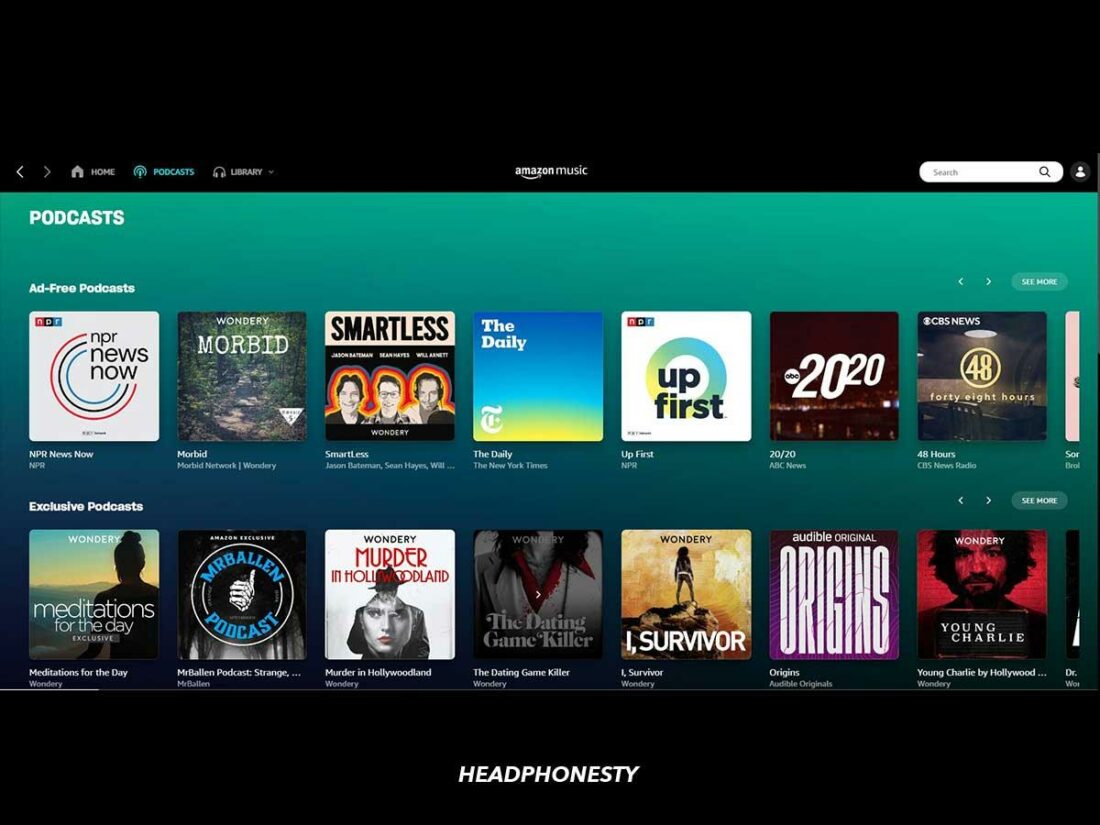
Amazon Music offers podcasts covering everything from mainstream news to horror stories. There are also exclusive shows like Origins by Audible Originals, The Old Man & the Three, and MrBallen.
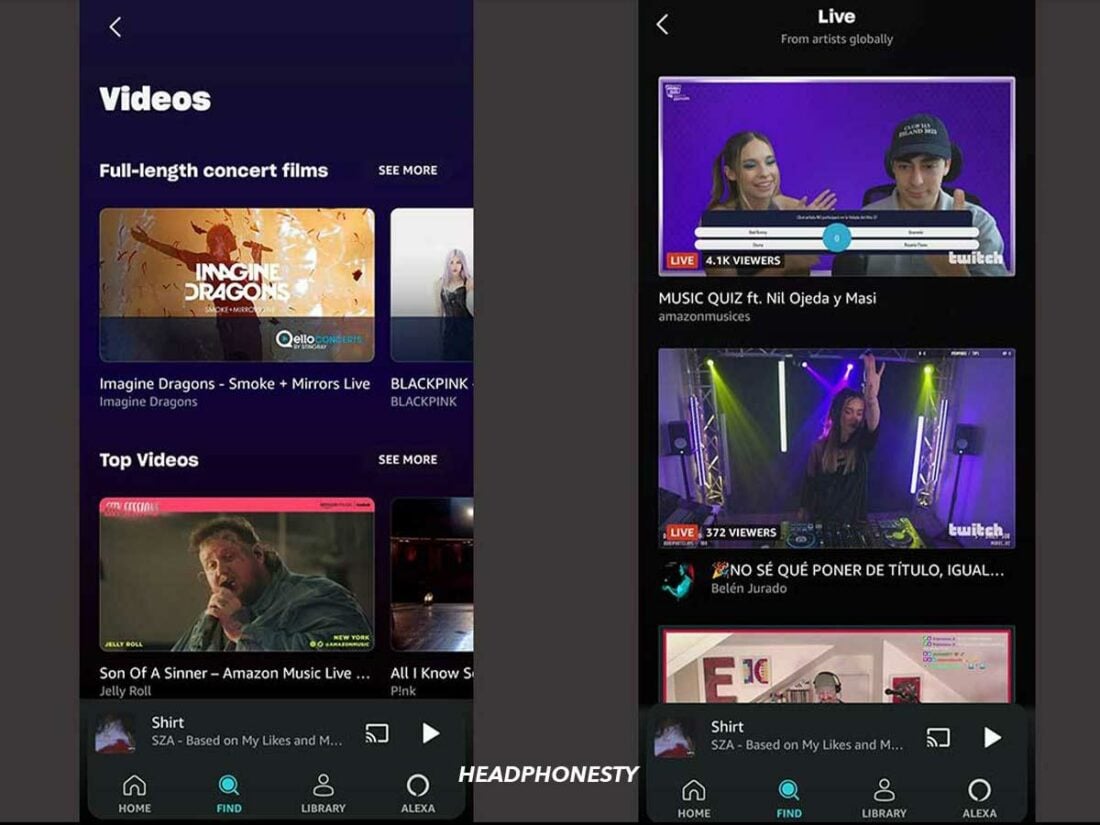
There is also an expansive library of Twitch live streams, music videos, and exclusive content. Some notable exclusives include Billie Eilish’s Prime Day Show, Behind the Hit, and My Rotation.
Conversely, Tidal’s content offerings are fewer, but they offer more variety targeted toward music enthusiasts. There are podcasts, behind-the-scenes videos, and documentaries that explore and provide deeper insight into the music industry. A noteworthy example is the Rap Radar podcast, which has hosted discussions with big shots like Jay-Z and Drake on their lives beyond music.
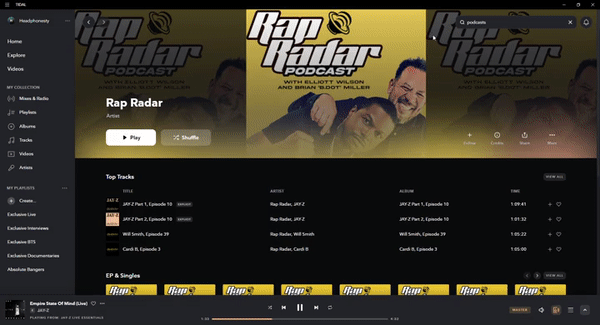
Additionally, when you pay for a Tidal subscription, you contribute to the growth of emerging artists through the Tidal Rising program.
Verdict: Which is more worth it?
Both platforms offer great depths of music and non-music content – and are excellent for different purposes.
If you’re interested in the music industry, Tidal’s collection of industry-related podcasts, behind-the-scenes, and documentaries offers countless hours of content. Additionally, using Tidal also means you’re supporting the growth of new artists through the Tidal Rising program.
Amazon Music’s broader content range also has a certain appeal, especially if you prefer an all-in-one streaming platform as a source of your daily content. Its collection of music, podcasts, news, music videos, and documentaries is nothing to scoff at.
Audio Quality
Most major music streaming platforms today, including Amazon Music and Tidal, offer lossless audio. There are several different audio quality options from both of these platforms. Let’s take a look at them side-by-side:
| Audio quality setting | Amazon Music | Tidal |
|---|---|---|
| Best Available | Depends on connection | N/A |
| Data Saver | 24 - 96 kbps* | N/A |
| Standard / Normal | 128 - 192 kbps* | 160 kbps (AAC) |
| High | N/A | 320 kbps (AAC) |
| HD / HiFi | 850 kbps (FLAC) | 1,411 (FLAC) |
| Ultra HD / Master | 3,730 kbps (FLAC) | 2,304 - 9,216 kbps (FLAC, WAV) |
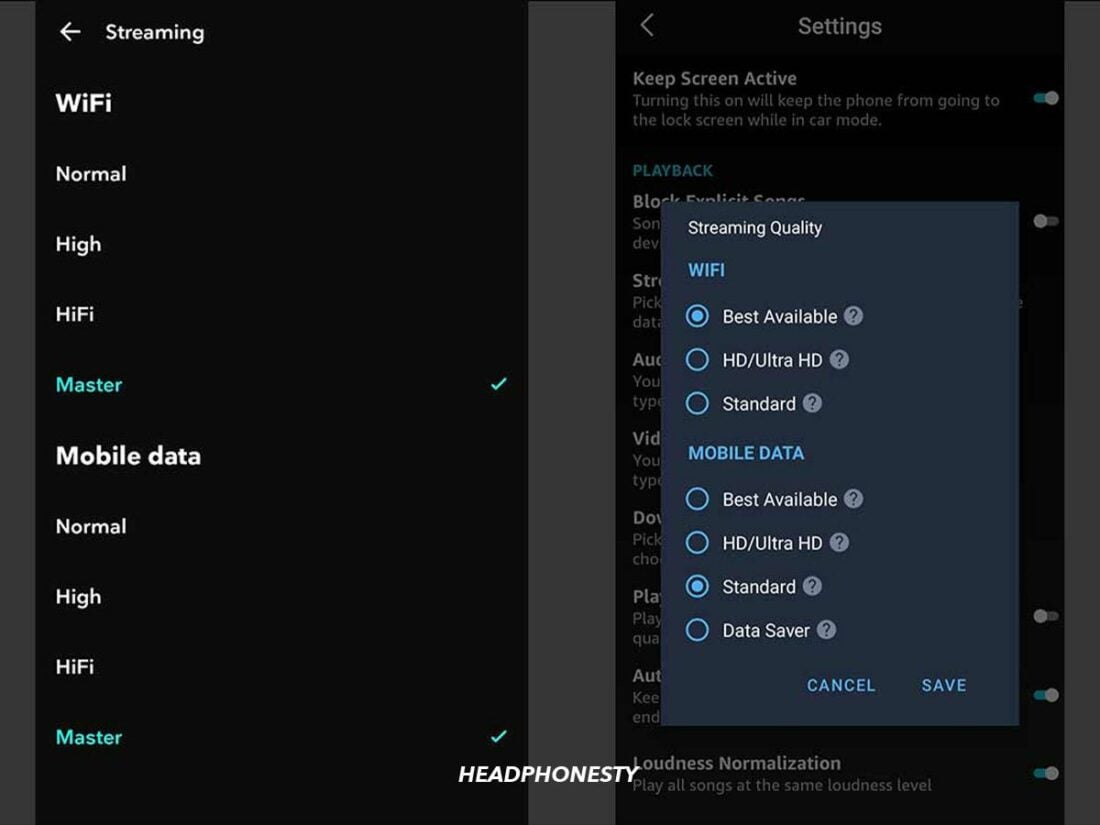
Loading JVKE’s Golden Hour at Ultra HD took roughly 3.1 seconds to load on Amazon Music. Tidal loaded the same song at Master quality slightly faster at 2.8 seconds. Changing the settings to Standard/Normal reduced the loading speed to a barely noticeable 1.5-second delay on both platforms.
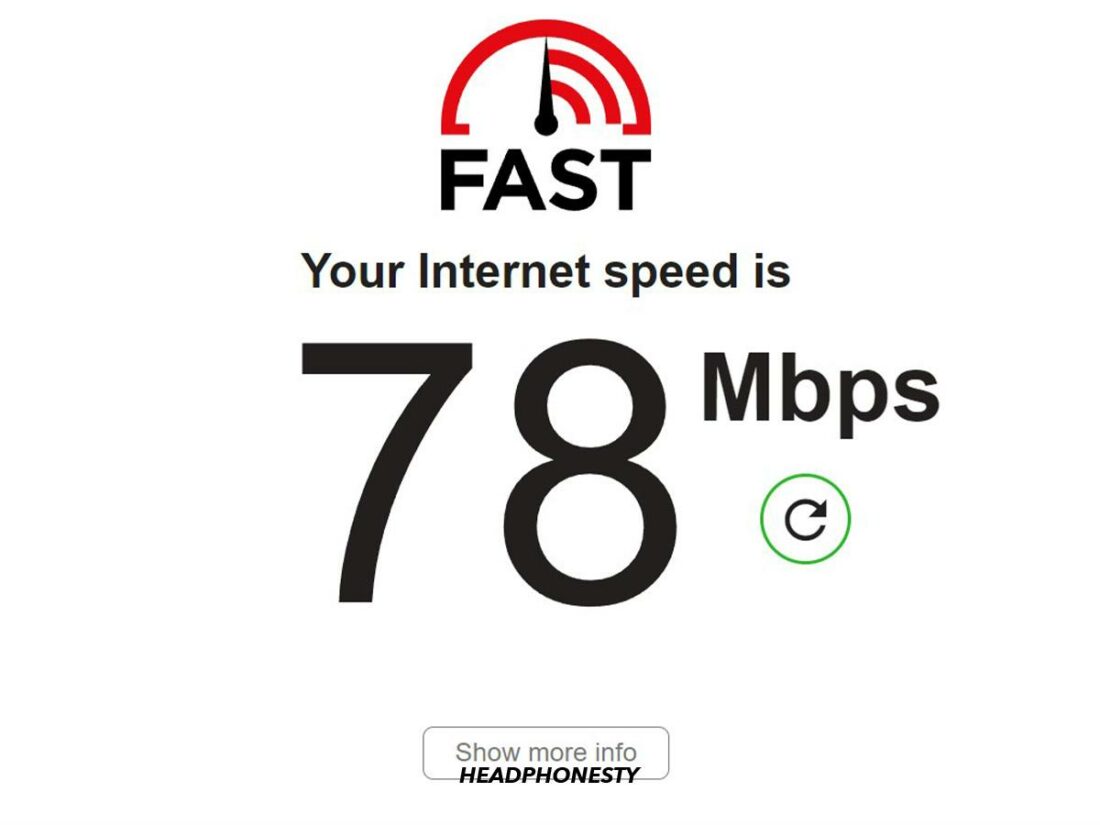
Considering I had a modest 78 Mbps connection, it wasn’t a bad experience. I’m not really bothered with the load time if it means my songs sound better. But others, especially those with spotty internet, may find the delays annoying.
For those who prioritize audio quality over conserving data usage, the HD/HiFi quality would consume about 330 MB of data per hour. At the same time, the Ultra HD/Master quality requires between 720 MB – 1.32GB of data an hour.
Right off the bat, Tidal stood out to me with an immense soundstage, better clarity, and overall greater depth of sound. It also sounds more well-balanced across all frequencies.
Switching over to Amazon Music, there’s a noticeable difference in sound quality. It sounds slightly muddier, with the lows often overwhelming the nuances in the mid-range frequencies. My test tracks also sound narrower, with less prominent details across the board.
Apart from the standard sound quality settings, both platforms are also compatible with Dolby Atmos and 360 Reality Audio.
Turning on the 360 Reality Audio significantly enhances the soundstage and imaging on both platforms. Interestingly enough, all songs I tested with 360 Reality Audio format sound identical on Amazon Music and Tidal.
Verdict: Which is more worth it?
Tidal sounds noticeably better than Amazon Music across the board, regardless of the music genre. Plus, it also offers more audio quality settings outside of the lossless options for those who want to conserve data or storage consumptions.
With Amazon Music combining HD and Ultra HD quality settings, it forces you to stream the best quality of the song. This means you may experience stutters if you don’t have a stable internet connection. It also limits your options to Data Saver, Standard, and HD/Ultra HD.
Tidal offers more sound quality options for different situations. For instance, if you’re not on WiFi, the High setting on Tidal is a nice middle ground with good quality and modest data consumption.
Music Discovery
When it comes to a streaming platform, music discovery is among the key features to consider – especially if you’re looking to expand your musical horizons.
But with the massive libraries that Amazon Music and Tidal have, it doesn’t take long before becoming overwhelmed with song options. That’s where their algorithms come in to tailor the experience with suggested content.
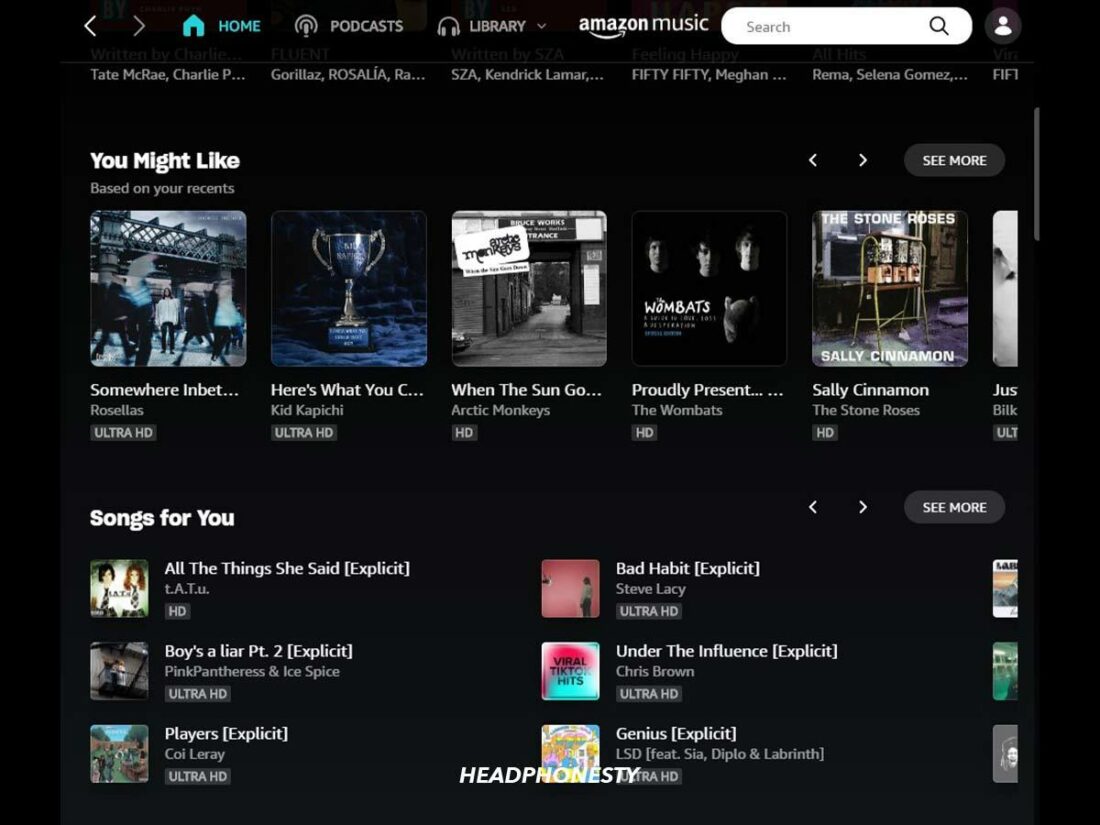
The first thing I like about Amazon Music is the plethora of curated playlists, stations, and tracks on the home page. Like many other platforms, Amazon Music also uses a machine learning algorithm to tailor your personalized music discovery. This immediately shows in the tracks listed under the You Might Like section.
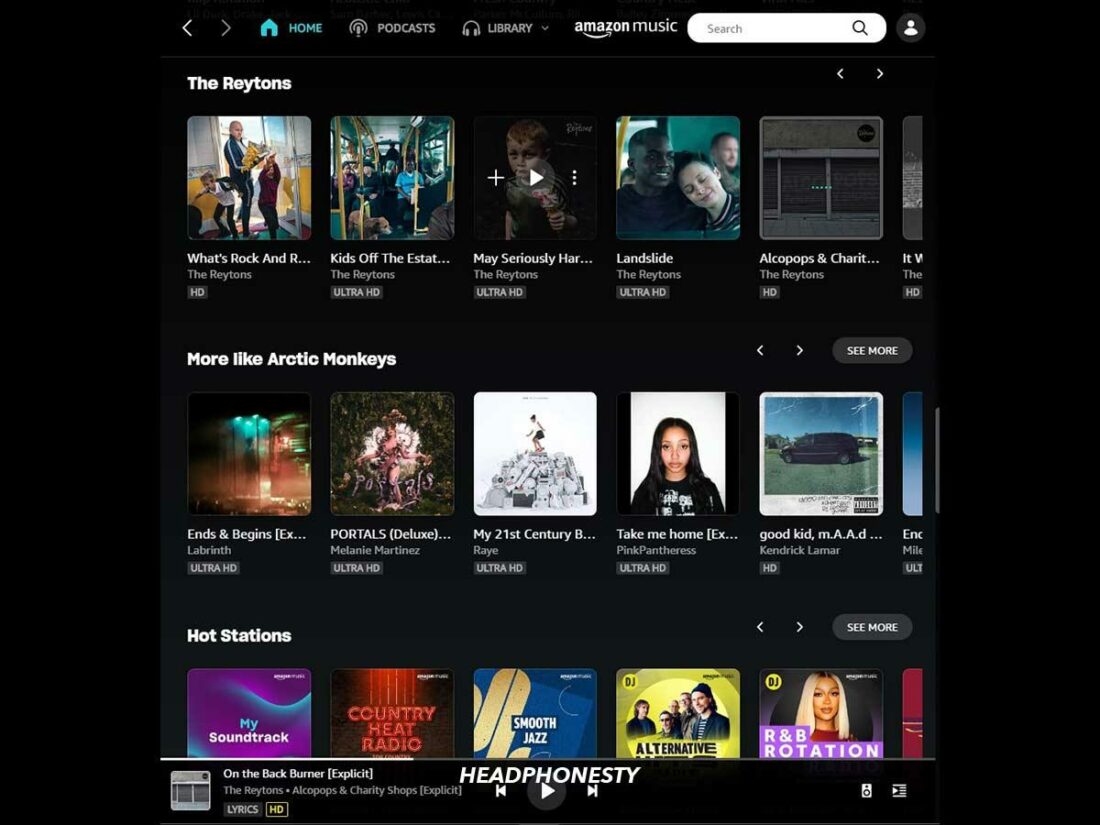
I’m a big Arctic Monkeys fan, and the first album I binged on Amazon Music was Favourite Worst Nightmare. Moments after finishing the album, I refreshed the home page to find the addition of The Reyton’s On the Back Burner to the recommended lists. I gave it a listen, and it was as spot-on as it could be.
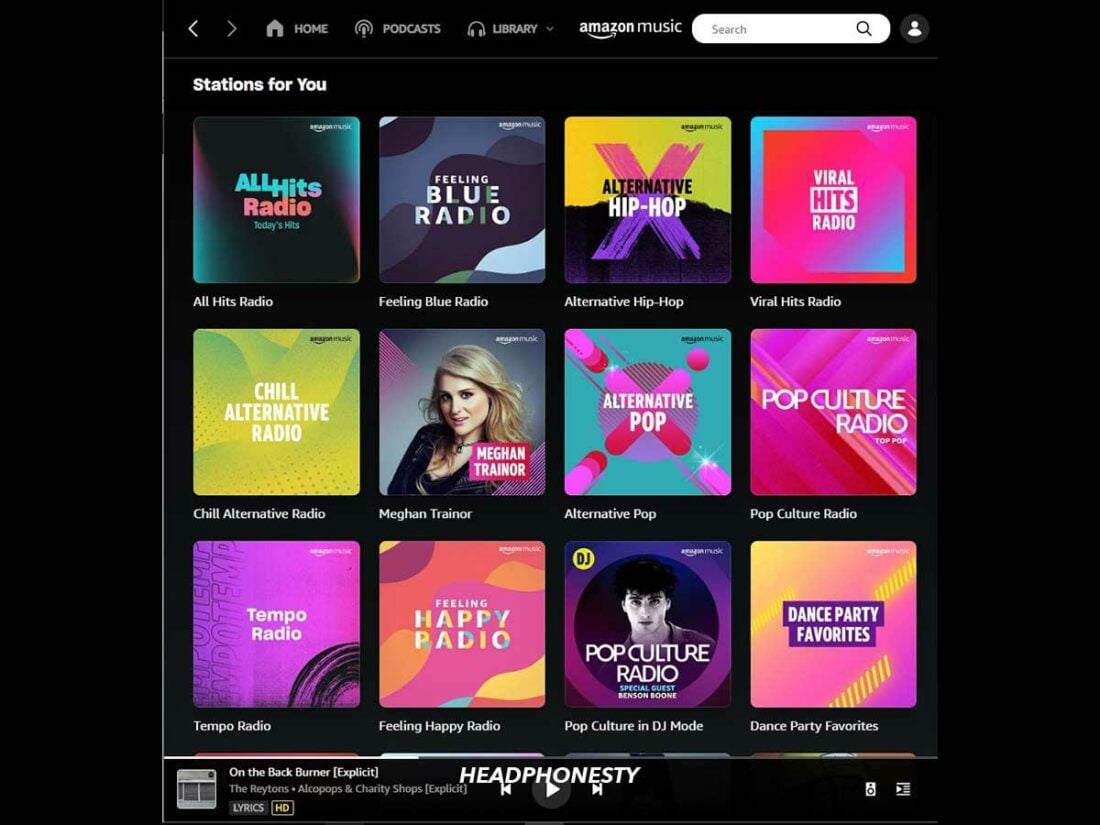
The Home tab also showcases recommended playlists based on the artists you follow under the Playlist for [artist name] Fans sections and trending/hot songs. I also love the Stations for You section. These stations don’t show you what’s playing next, which to me, is an ideal way to discover new music.
One thing I dislike about Amazon Music is that there’s no easy way to enhance your playlist. The playlist screen only contains the tracks you already added – and nothing else.
Another point of improvement for me is the lack of auto-generated playlists. It only recommends existing playlists or tracks I might like, and I have to manually add them to my playlists.
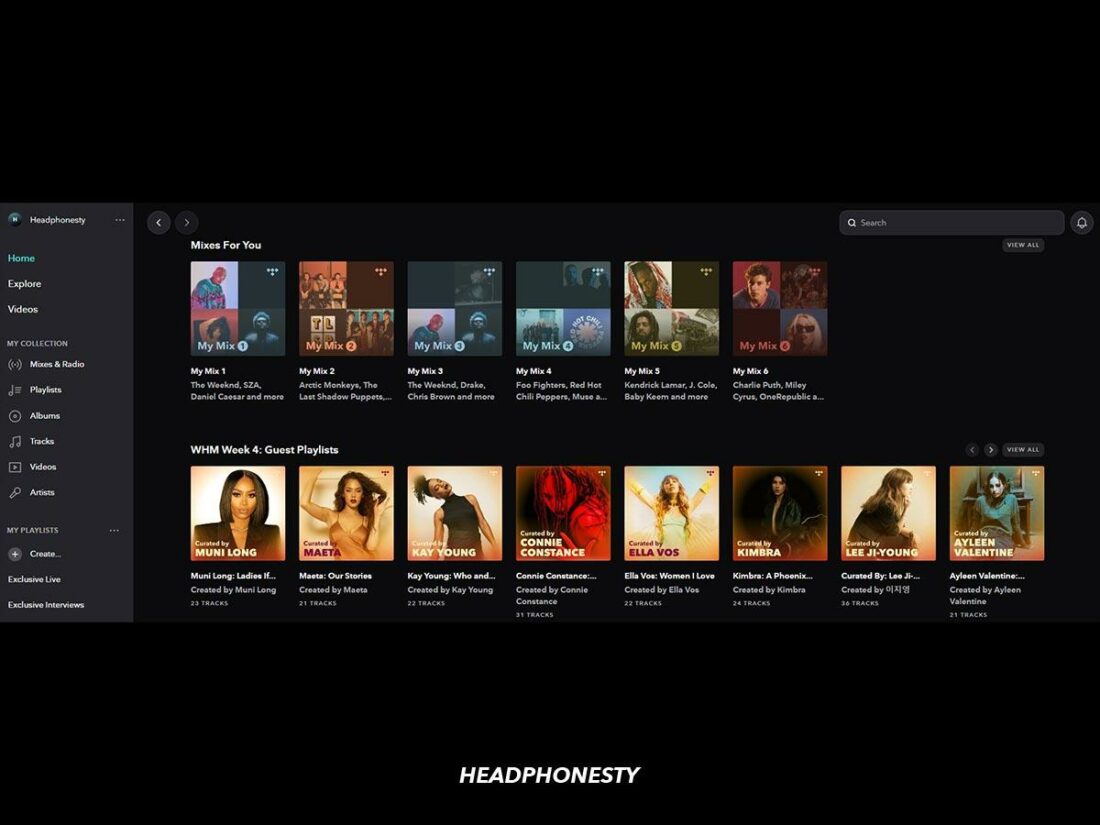
That brings us to what makes Tidal different – and dare I say better – in terms of music discovery. After signing up, Tidal generates a Welcome Mix playlist based on the artists you follow. After a few days’ use, Tidal generates at least six personalized mixes based on different groups of artists you like.
Tidal’s homepage is also filled with curated playlists based on the artists you follow and the tracks you liked or added to your library. On the mobile app, you can also join live sessions, allowing you to listen to what others are listening to.
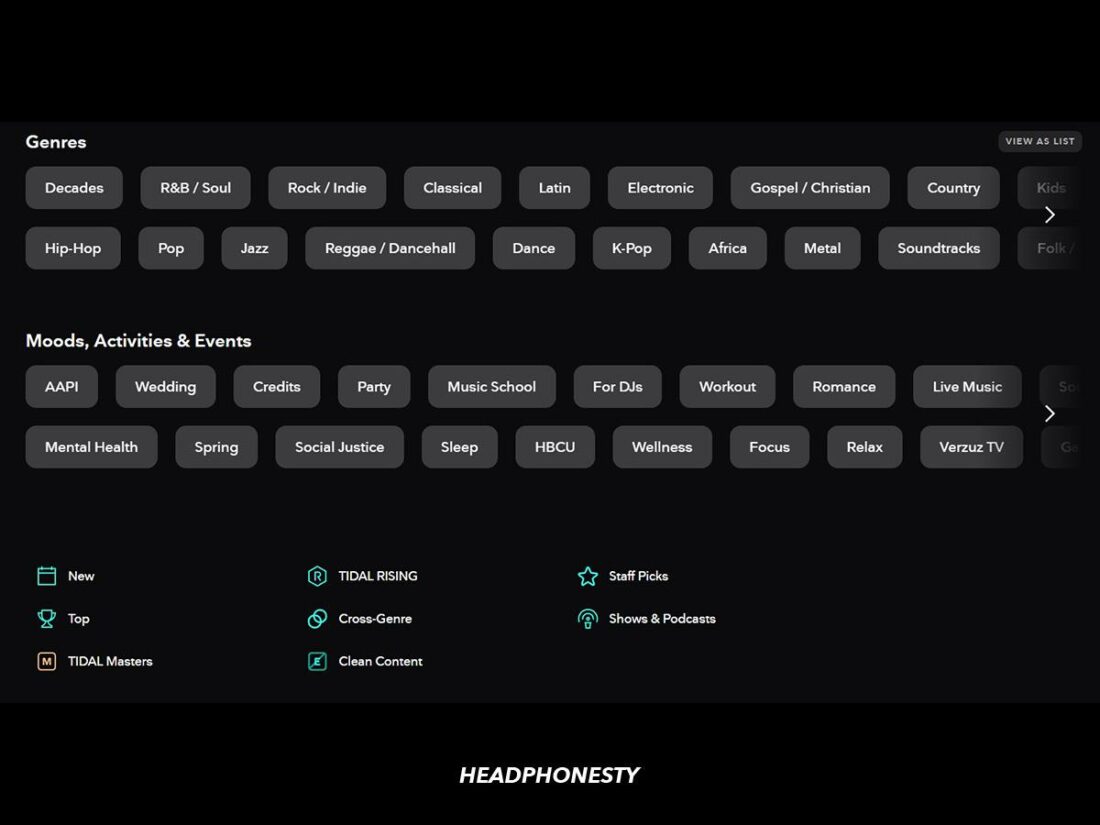
The Explore tab on Tidal lets you discover music based on genres, moods, activities, and events. There’s also a dedicated tab for Tidal Rising, which showcases emerging artists vetted directly by Tidal. To top it off, Tidal has a Staff Picks section that houses hundreds of expert-curated playlists, tracks, and albums.
From my experience using Tidal, it recommended new artists I haven’t heard of – which is excellent for broadening your musical horizons. Another thing I noticed is that Tidal tends to suggest up-and-coming artists instead of household names.
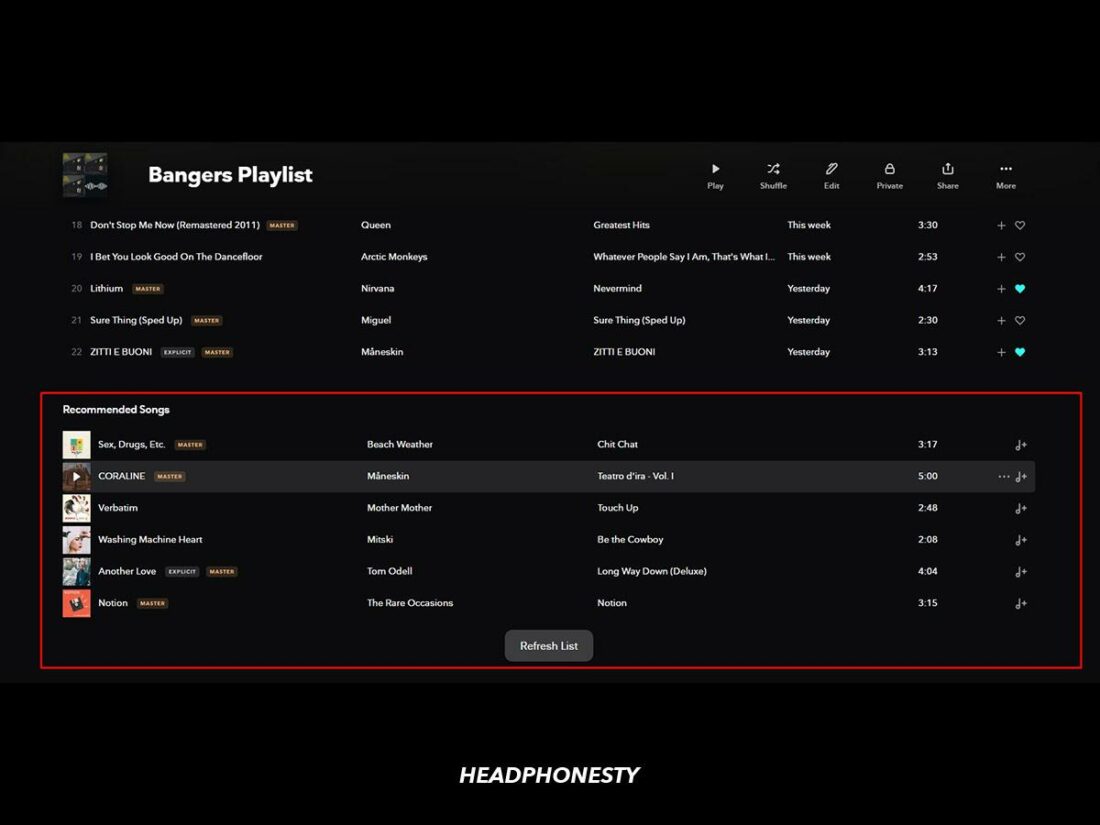
As far as playlist enhancement goes, Tidal wins big time with the songs recommendation readily available under your list of tracks. What’s better is that the recommended songs list keeps refreshing – you can find heaps of new artists and tracks from this feature alone.
Verdict: Which is more worth it?
While both platforms use machine learning algorithms to recommend new songs for you, Tidal’s implementation is visibly more user-oriented and practical. Instead of just recommending songs, Tidal auto-generates personalized playlists based on your listening activities.
This auto-generation process allows you to grow your music library without actively looking for new artists or tracks. On Amazon, you still need to actively select which recommended artists or tracks you want to include in your library.
Ease of Use
Amazon Music and Tidal have similar dark-themed designs on their mobile, web, and desktop apps. Both apps also offer good functionality while still looking clean and uncluttered.
Here are some stand-out features on both platforms:
Platform availability
Amazon Music offers dedicated applications for all major platforms, including iOS, Android, Windows, and Mac. It also has a web-based app, but you can’t access Ultra HD quality on it.
You can also use Amazon Music to play music in your car using Apple’s CarPlay and Android Auto. It also has built-in compatibility with Roku, Fire TV, and Fire Tablet.
Similarly, Tidal provides dedicated applications for iOS and Android devices, web browsers, Windows, and Mac. It also supports popular smart devices like Amazon Echo, Sonos, and Chromecast.
Tidal also has built-in compatibility for car brands, smart TVs, turntables, and audio interfaces through official partnerships in addition to CarPlay and Android Auto.
User interface design
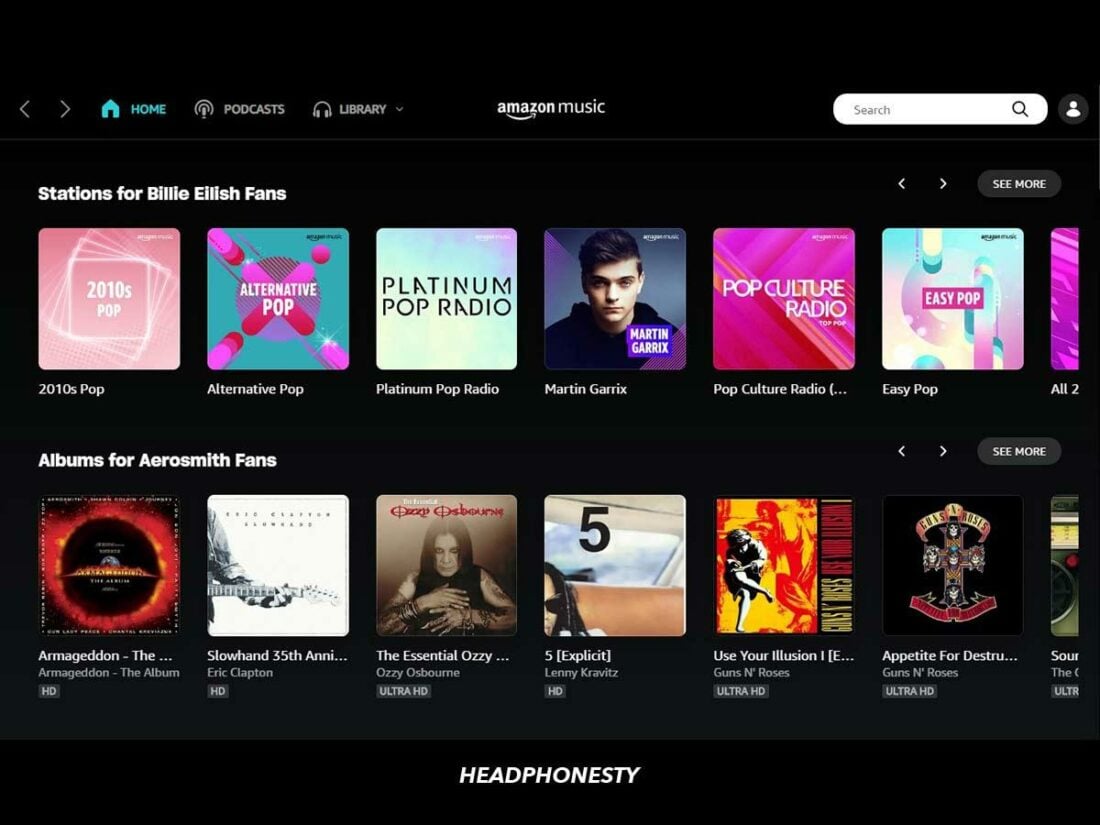
What immediately stands out is Amazon Music’s simpler and cleaner design, with the primary navigation at the top. The navigation includes buttons for your Home feed, Podcasts feed, Library, and Search bar.
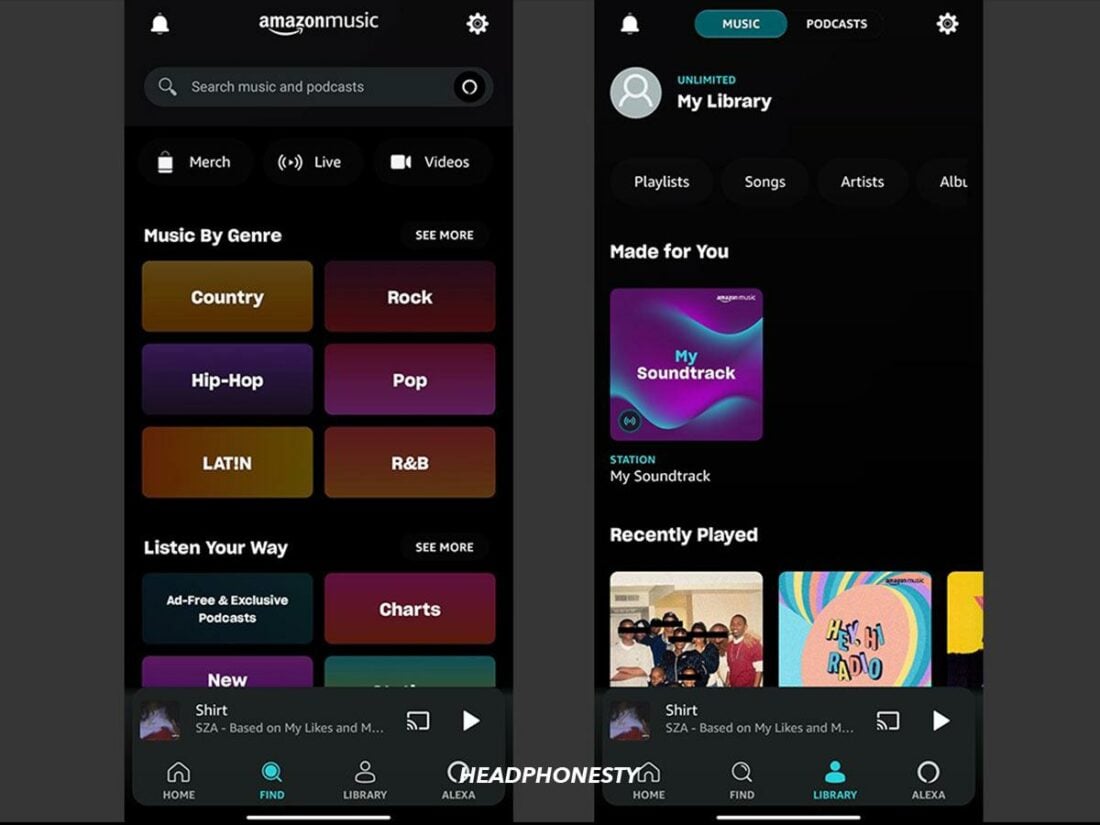
Amazon Music’s mobile app is slightly more populated with buttons. What I find puzzling is Amazon’s decision to hide the Live and Videos tab under the Find menu. I was already aware that Amazon Music offers videos, but it took me a while to finally find them. Plus, the Live and Videos tabs are not on the desktop app.
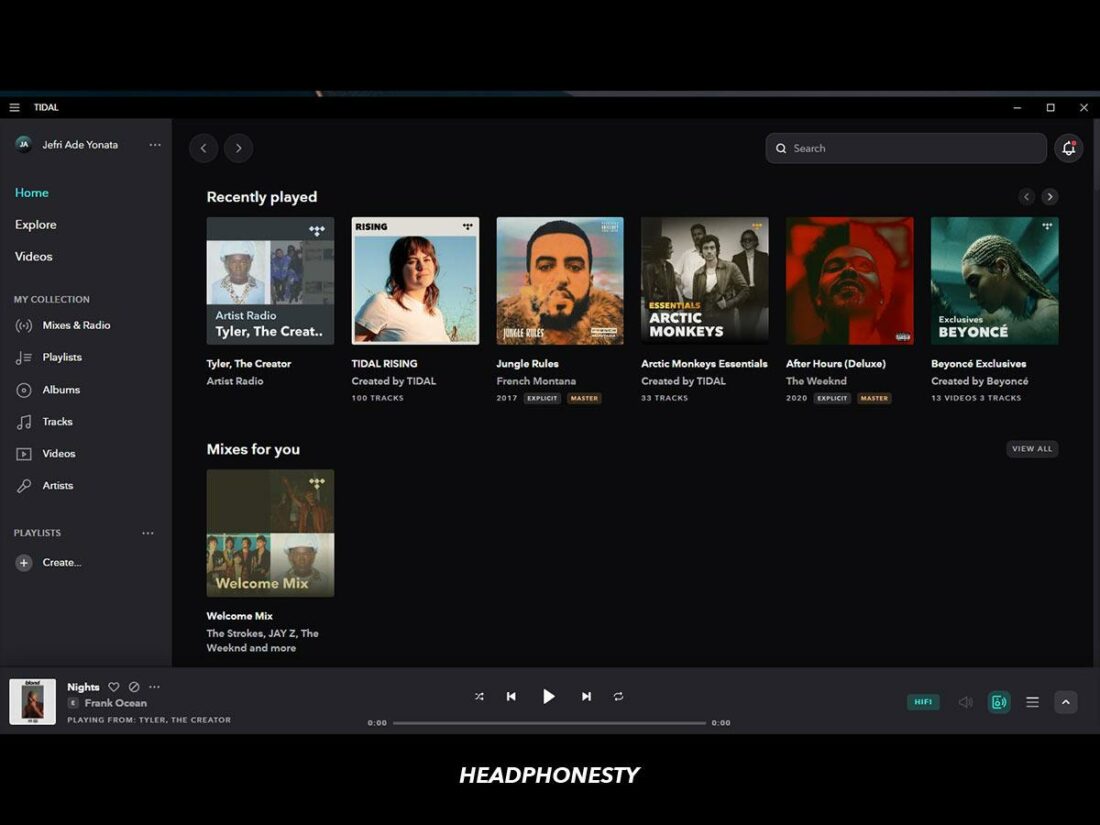
Tidal’s web and desktop apps have a sidebar on the left that contains buttons for the Home Feed, Explore, and Videos tabs. It also gives you quick access to your saved content and playlists.
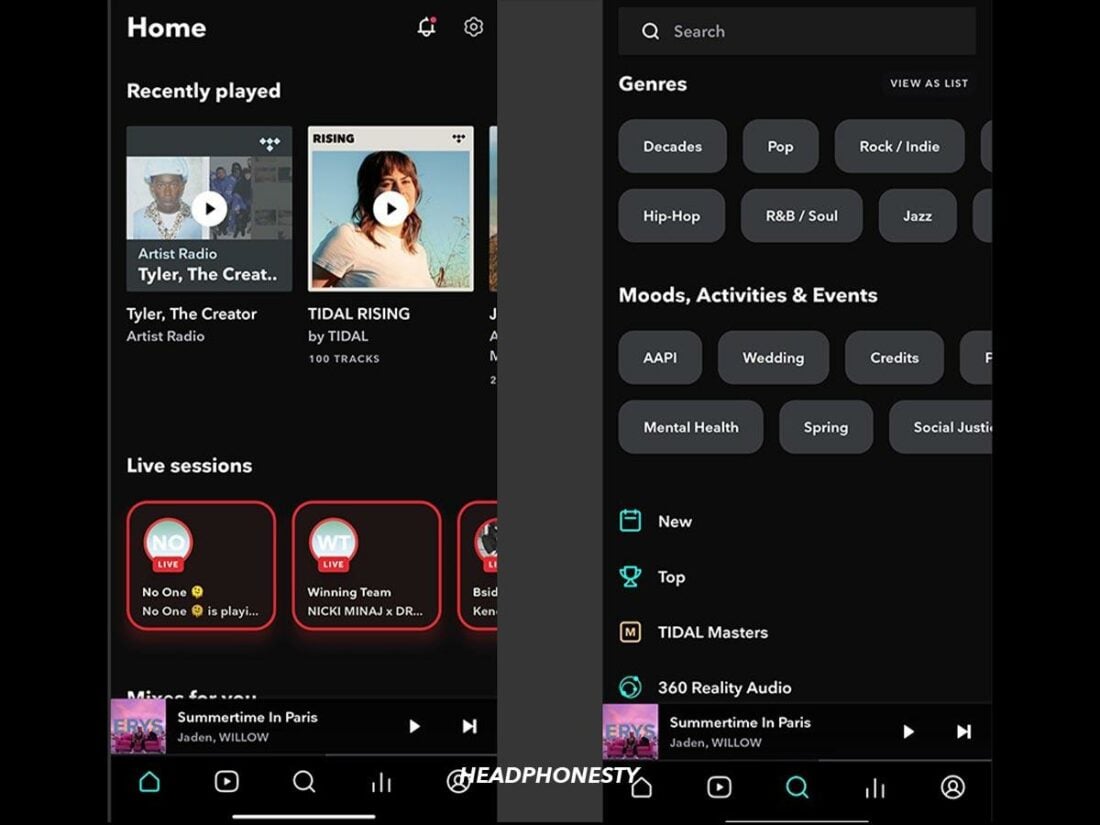
Their mobile app is quite straightforward, with a bottom navigation bar providing quick access to Home, Explore, My Collection, and Search. The Explore section lets users discover new music based on genres, moods, and curated playlists.
Drag-and-drop feature
Both desktop apps feature a drag-and-drop function to add tracks or albums to your library better.
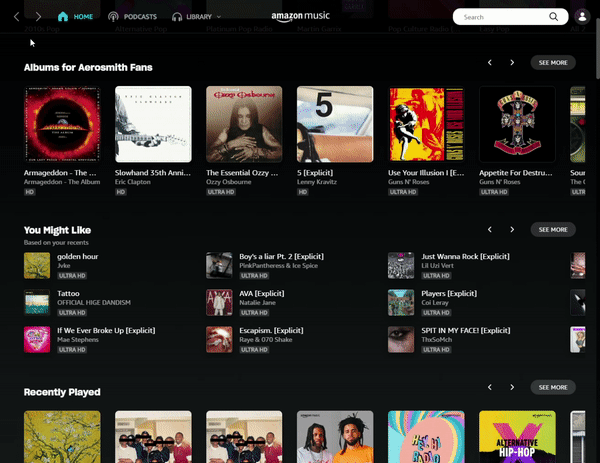
On Amazon Music, you can add tracks to a playlist, queue it to play next, or download it to listen offline. But as someone more familiar with the left sidebar layout, it felt unusual to drag the song to the right side.
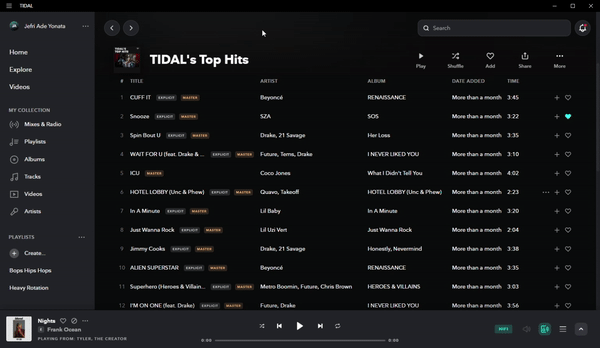
The drag-and-drop function on Tidal feels much more familiar since it uses the left sidebar layout, just like most streaming apps like Spotify, Apple Music, and YouTube Music.
Library management
If you have a gigantic collection of tracks in your library, you’d be glad to know that both of these platforms offer an intricate filtering and sorting system.
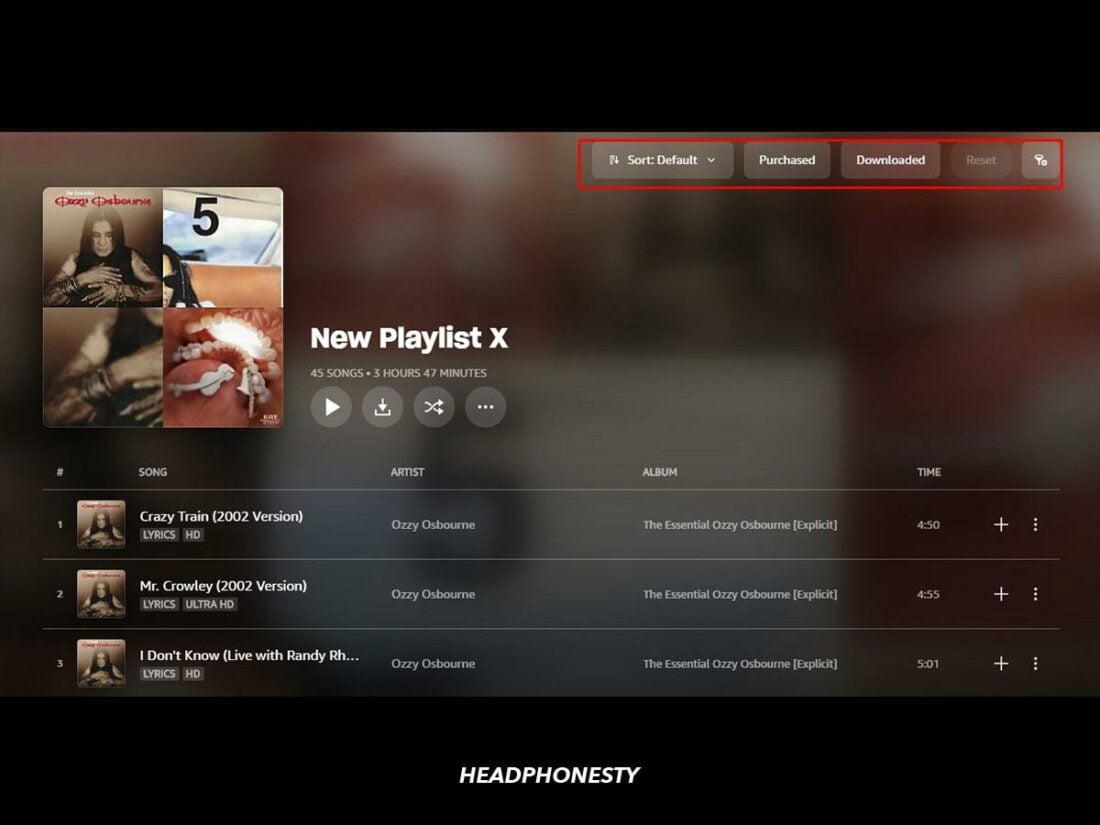
Amazon doesn’t let you search for tracks in your library manually. But you can sort tracks based on title, artist, album, and duration through a drop-down button. You can also toggle the Downloaded and Purchased filters.
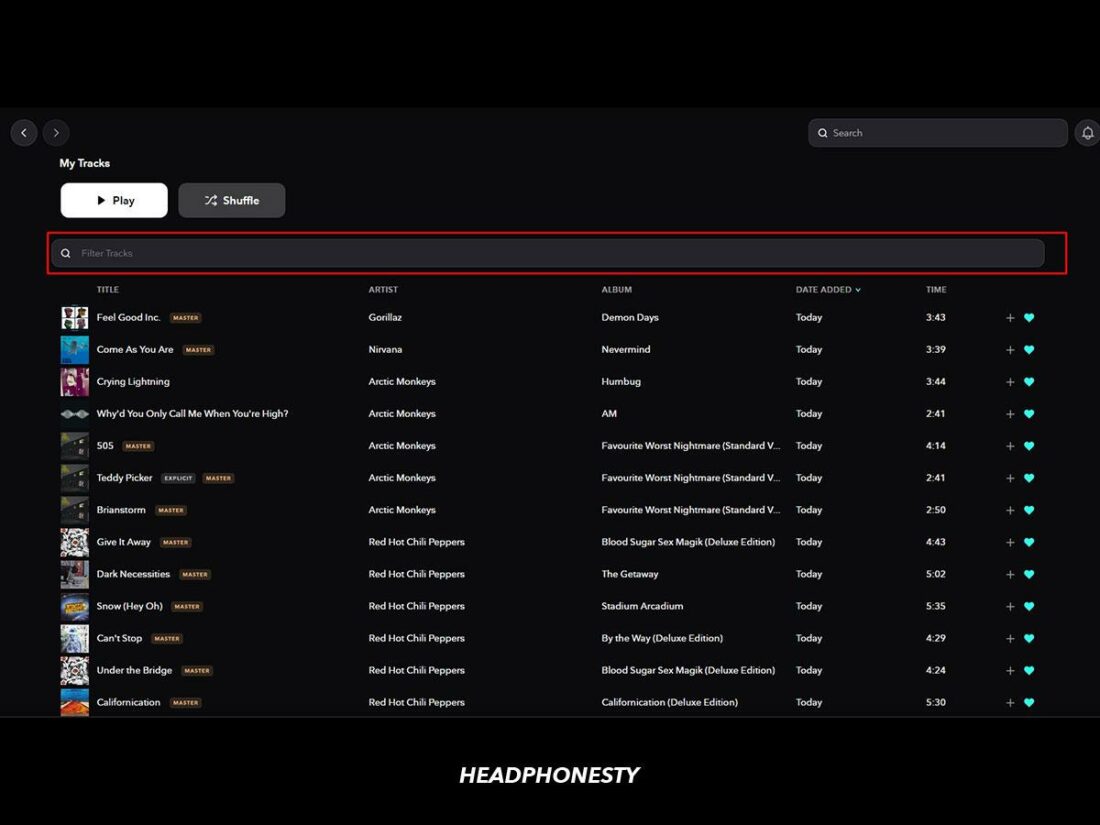
On Tidal, you can manually filter tracks by their title, artists, or album name. You can also sort them using the same parameters or by the track’s durations.
Verdict: Which is more worth it?
For the most part, these two apps are neck-to-neck regarding ease of use. But there’s one major design flaw on Amazon Music: you can’t access video and live stream content on the desktop app. On the other hand, you can access Tidal’s entire music videos and documentaries collection on both desktop and mobile apps.
But other than that, the interface on both apps is also very functional with minimum clutter, allowing you to navigate through all the content without being overwhelmed. The drag-and-drop features on both apps also make adding new content to your library much more manageable.
Additional Features
Extra features on music streaming platforms can significantly improve your overall experience. Let’s review some of the additional features offered by Tidal and Apple Music:
Exclusive Mode
Exclusive Mode is a feature that enhances audio playback quality by bypassing system-level sound processing. When activated, it ensures a direct, unaltered audio output from the application to your headphones.
On Tidal, this feature is accessible from Settings > Sound > More Settings > Exclusive Mode.
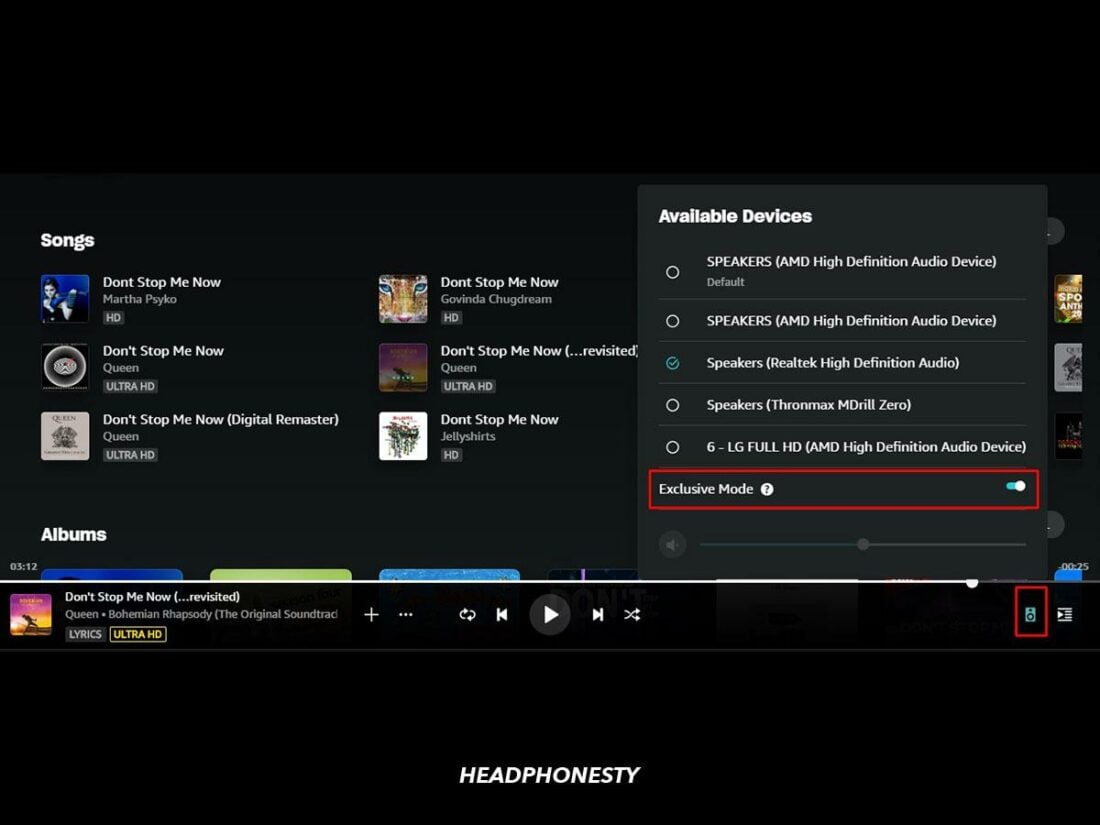
On Amazon, you can activate this feature by clicking on the speaker icon on the playback control bar.
Lyrics
Both apps support beat-by-beat lyrics to ensure you don’t sing the wrong words in your sing-along sessions. You can also jump around parts of the tracks by clicking or tapping lines on the lyrics.
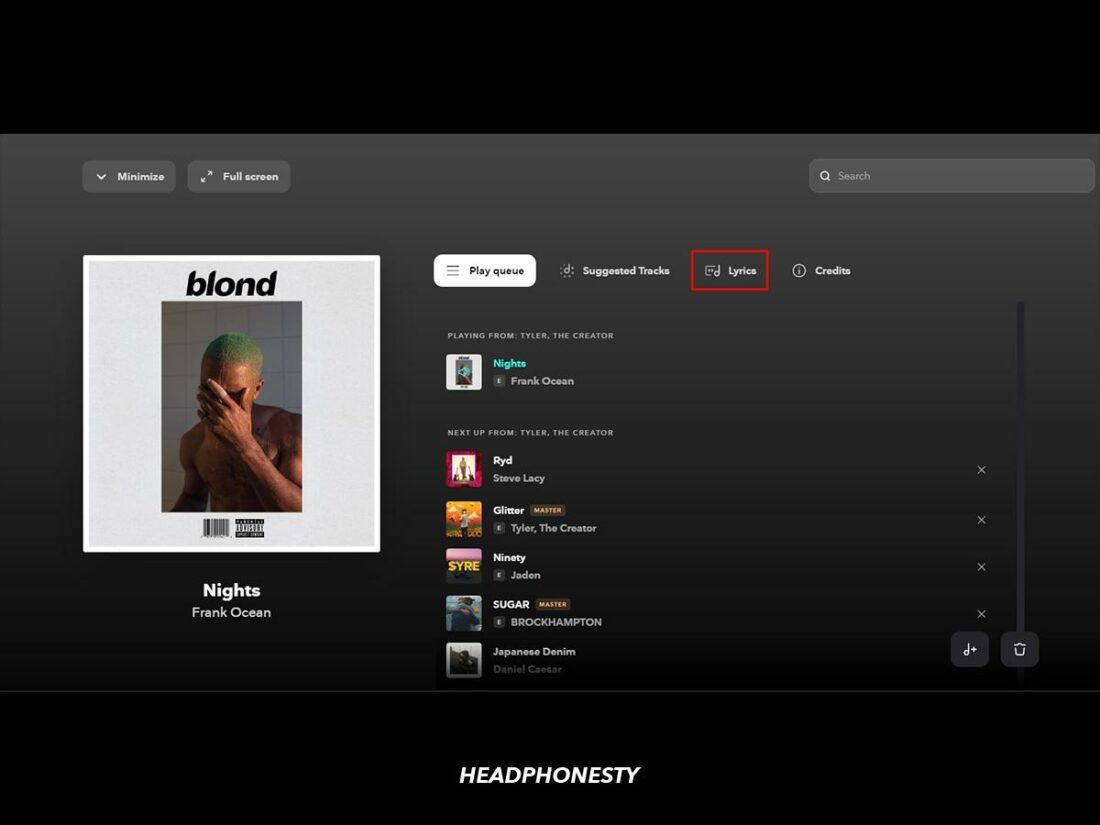
On Tidal, you need to expand the playback control bar, then click on the music note icon to show the lyrics.
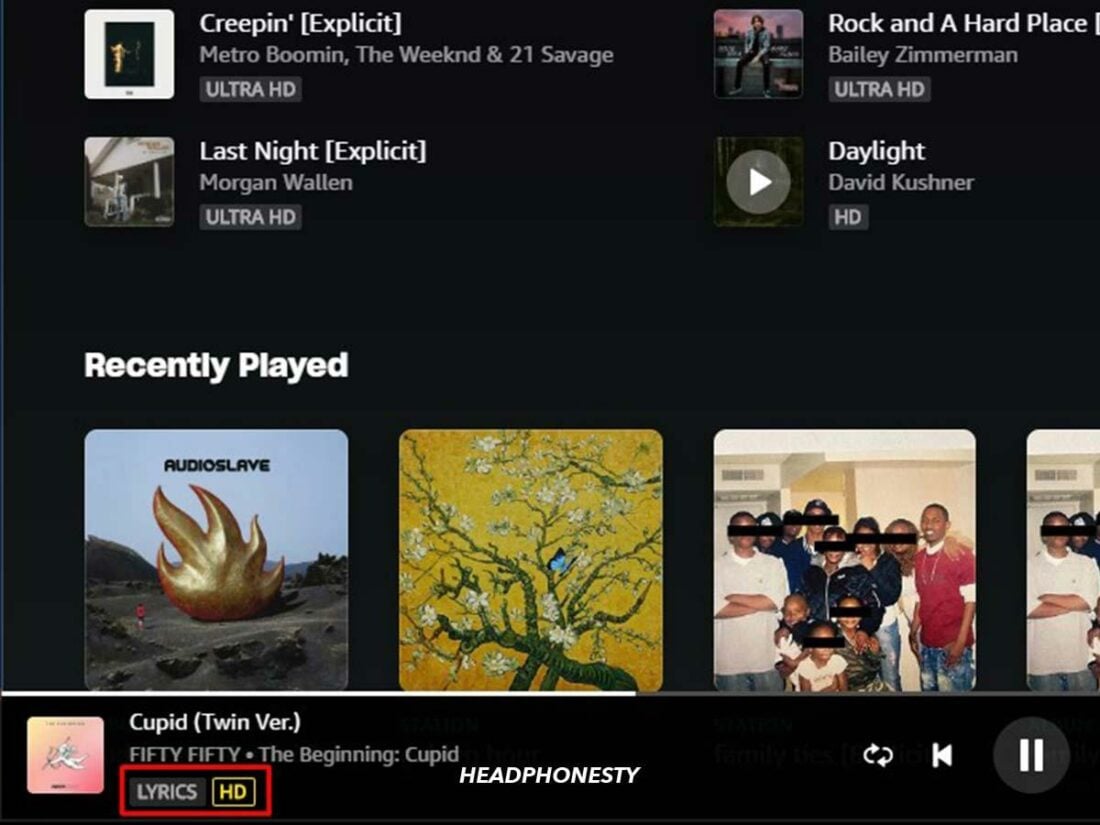
On the Amazon Music desktop app, you can click LYRICS under the song title. On the mobile app, you need to swipe up from the playback screen to view the lyrics.
Social sharing
If you enjoy sharing music and playlists with friends, you’ll be glad to know that Amazon Music and Tidal offer decent social sharing features.
Aside from the link-sharing feature, Amazon Music and Tidal also have year-in-review versions (a.k.a Spotify Wrapped duplicates). Last year, Amazon Music had the My Year in Review 2022, whereas Tidal had their aptly named 2022 Rewind.
Verdict: Which is more worth it?
Both platforms offer similar additional features, so you won’t really miss out on much if you choose one over the other. Overall, it really depends on your personal preference.
How Much Do Amazon Music and Tidal Pay Artists?
Aside from all the features mentioned above, consider how much of your subscription money actually goes to your favorite artists. Let’s take a look at how much these streaming platforms pay artists:
| Platform | Pay per stream | Streams to get $1,000 |
|---|---|---|
| Tidal | $0.013 | 76,924 |
| Apple Music | $0.01 | 100,000 |
| Amazon Music | $0.004 | 250,000 |
| Spotify | $0.0033 | 303,030 |
| YouTube Music | $0.008 | 125,000 |
| Pandora | $0.0013 | 769,231 |
| Deezer | $0.0064 | 156,250 |
| Qobuz | $0.043 | 23,255 |
Regarding artist payout rates, Amazon Music and Tidal have some of the highest per-stream rates among other platforms. Amazon Music has a $0.004 per stream rate, whereas Tidal pays $0.013 per stream.
Amazon Music uses the market-centric payment system to calculate artist payouts. With this system, they compile all of their streaming revenues into one big pool. Then, the artists get paid based on how many streams their songs get.
Additionally, there are also different revenue streams that artists can get from Amazon Music:
- Amazon Store lets you purchase a digital copy of songs or albums from your favorite artists. Amazon takes roughly 30% of the total and the remaining amount goes directly to the artists.
- Amazon Music Prime listeners also contribute to artist payouts. These streams pay roughly $0.00139 per stream.
On the other hand, Tidal used to have the Direct Artist Payout (DAP) program, which set aside 10% of your subscription fee to the artist whose songs you stream the most. This amount is added on top of the per-stream payout from the platform.
Sadly, Tidal canceled the DAP program in March 2023. It was deemed ineffective – having generated only $500,000 since its launch in 2021. Additionally, a Tidal employee confirmed that most of the fund goes to bigger artists – which was against their true intention.
Now, Tidal effectively reverts back to paying artists based on the number of streams they get. Even so, Tidal’s CEO Jesse Dorogusker claims that Tidal HiFi Plus still pays artists more than other platforms.
With the DAP canceled, Tidal won’t be paying your top-listened artist a portion of your HiFi Plus subscription anymore. While unfortunate, that also means Tidal has more money to invest in the Tidal Rising program.
In an email newsletter, Tidal announced that they’ve invested $6 million in 2022 to help promote artists. This includes documentaries and events like Tidal Rising X Atlanta live event that hosts Sakura, SwaVay, Lunar Vacation, and Tom The Mail Man.
Verdict: Which is more worth it?
Despite the DAP failure, Tidal continues its support through Tidal Rising – which I think will bring much-needed exposure and success to emerging artists in the long run. And it’s still worth considering that Tidal has the higher payout per stream.
But on the flip side, Amazon’s digital music store allows you to support artists through direct purchase of their content. If you add your purchase with the per-stream payout, Amazon Music could net the artist more. But then again, that means more money coming out of your pocket outside of the subscription fee.
At the end of the day, it’s up to you to decide. If you want a non-direct way to support your favorite artists, Tidal is the app to use. But if you don’t mind reaching deeper into your pocket, then buying the track or album through Amazon’s digital store is an excellent option.
Which Should You Go For?
Here’s a quick recap of all the good things you can get from Amazon Music and Tidal:
| Amazon Music | Tidal |
|---|---|
| Lossless audio quality (HD and Ultra HD) | Higher lossless audio quality (HiFi and Master) |
| Podcasts on a wide range of topics | Better music discovery through My Mixes |
| Option to purchase music from Amazon digital store | Exclusive tracks and performances |
| Music videos and live performances | Industry-related podcasts and documentaries |
| More original content and series | Higher payout and support for artists |
| Built-in Twitch live streams | More subscription plan options |
| Live radio feature |
While both of these platforms have their own strengths, Tidal has the upper hand after considering all of the features and perks combined.
Despite both offering lossless audio, playing songs on Tidal brings a fuller sound with a more immersive soundstage that brings it to a different level of listening experience that Amazon Music hasn’t achieved just yet.
Being made for artists by artists, Tidal has dedicated itself to providing more opportunities for emerging musicians through Tidal Rising. Tidal is the clear winner for those who care about supporting their favorite artists. Additionally, Tidal is more inclusive, with discounted plans for first responders and military personnel.
But that’s not to say Amazon Music is bad. On the contrary, the rich selection of music, live streams, radio shows, podcasts, and original content makes it more than just a music streaming platform. Despite having slightly lower audio quality than Tidal, Amazon Music has all you need to be an all-in-one app for casual listeners.
Conclusion
Overall, Amazon Music and Tidal are on somewhat equal footing in terms of the number of available songs, content variety, and ease of use – all of which are critical to your listening experience.
Beyond those factors, Tidal stands out with its superior sound quality, commitment to supporting artists, and extensive music-related content such as exclusive videos, interviews, and live performances. On the other hand, Amazon Music caters to a more mainstream audience, offering a wider range of podcast topics and original series alongside its extensive music library.
While Tidal excels in its dedication to supporting artists, Amazon Music’s broader content offerings make it an attractive choice for those seeking a diverse entertainment experience. Ultimately, the choice between the two platforms depends on individual preferences and priorities.
So, which music streaming platform do you want to try first? And if you’ve tried either platform, how was your experience using them? We’d love to hear your thoughts in the comments!
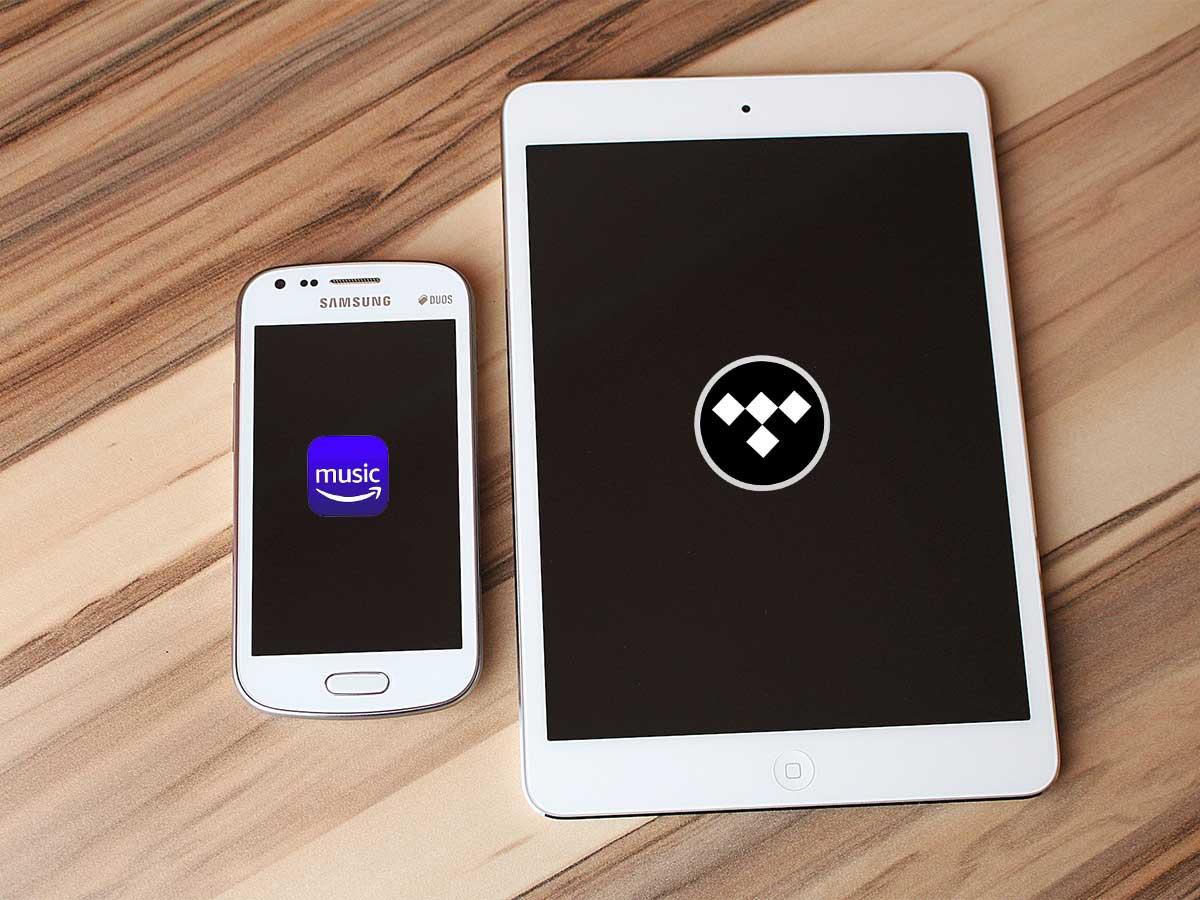
Even though Spotify does not do high res yet it would be interesting to compare user interface with others as it is quite good. I use Amazon and Spotify but Amazon is clumsy to me for day to day use. For example all downloads go into one folder and then play out of order. If I download an album on Spotify it is still a album and plays in order artist intended. In Amazon the album joins a common folder with other downloads and the plays in wrong order.